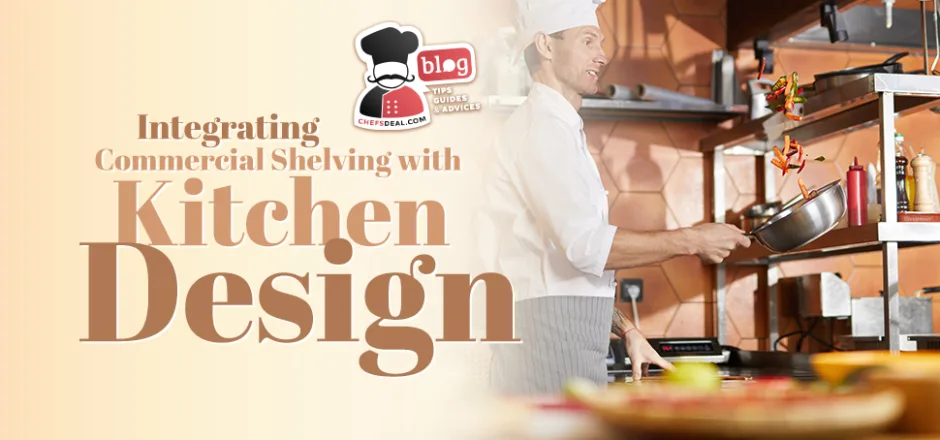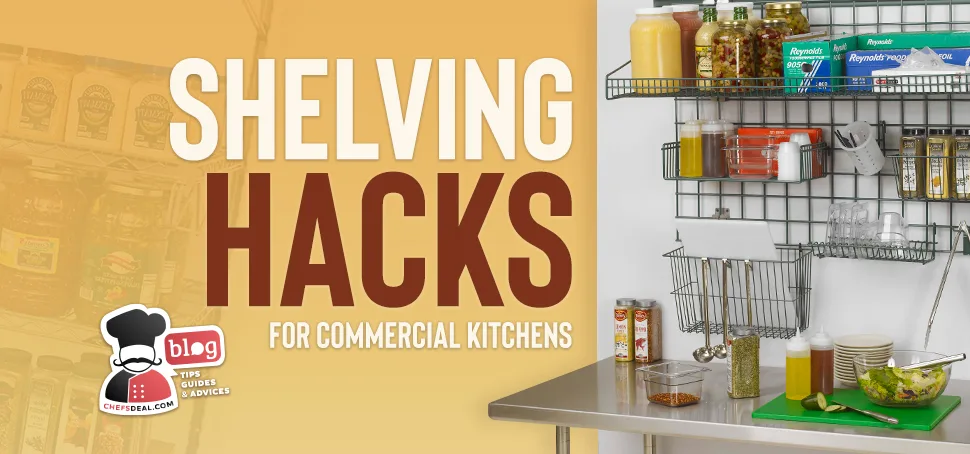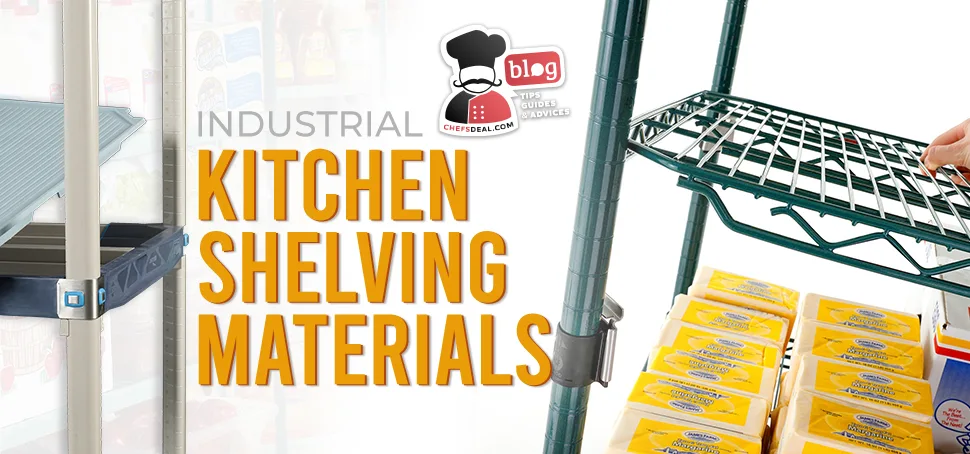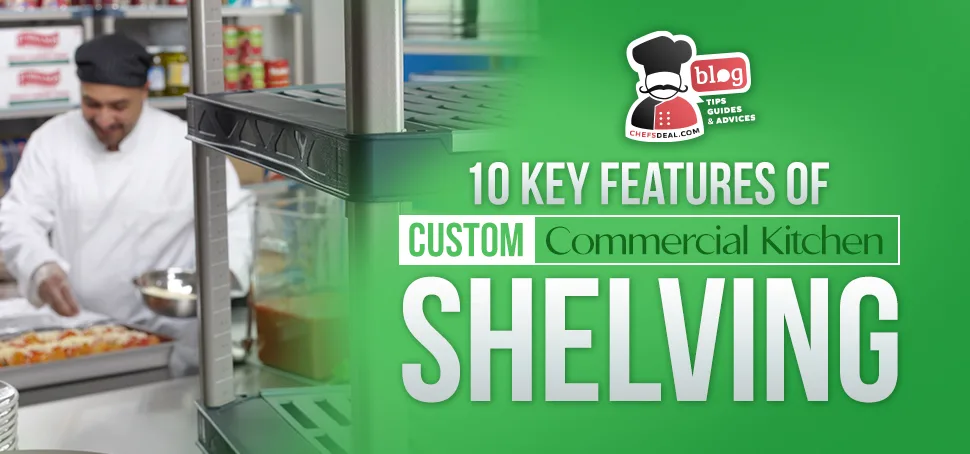Integrating commercial shelving with the kitchen design theme ensures enhanced aesthetics and a harmonious environment. It integrates with the kitchen layout for maximum storage space and workflow efficiency. Integrating shelving with common layout designs such as the assembly line, zone-style, island, and galley layouts optimizes workflow efficiency.
Customization options in commercial shelving solutions allow for the adaptation of shelving configurations, compartments, and finishes to suit the specific requirements of individual kitchen spaces. The right kitchen shelving material complements the overall look and theme of the kitchen, while the right shelving style meets the storage requirements and enhances functionality.
Understanding future trends in commercial kitchen shelving is crucial for ensuring that design choices meet current needs and are adaptable to upcoming innovations and shifts in kitchen dynamics.
Kitchen’s Design Themes
In commercial kitchens, the alignment of shelving choices with specific design themes is crucial for creating a cohesive environment that enhances both functionality and aesthetics. Effective shelving integration supports optimal performance, maintains orderly workflows, and contributes to the overall visual appeal of the space, essential for maximizing kitchen efficiency and staff productivity.
- Assembly Line Layout: Predominantly used in settings like fast food joints and pizzerias with limited menus, the assembly line layout streamlines operations by arranging equipment and shelving in a linear sequence from food preparation to service. Here, shelving should be strategically placed to facilitate easy access to ingredients and tools along the line. This arrangement minimizes movement and speeds up the assembly process, which is critical in high-volume, repetitive food production environments.
- Zone-Style Layout: This layout divides the kitchen into distinct areas or zones dedicated to specific tasks, such as salad preparation, meat handling, or baking. Shelving in each zone must be tailored to the specific needs of that section and equipped with appropriate materials and configurations that support the activities performed there. For example, shelving near grilling areas should withstand high temperatures, whereas those in the dishwashing zone need to resist moisture and facilitate drainage. Properly aligned shelving ensures that each chef has immediate access to the necessary tools and ingredients, enhancing focus and efficiency in their specialized tasks.
- Island Layout: Featuring a central island typically used for main cooking operations, with peripheral zones for prep, storage, and cleaning, the island layout promotes an efficient circular flow that facilitates communication and collaboration among staff. Shelving around the island should be designed to store commonly used cooking tools and ingredients, enabling chefs to access everything they need without leaving their stations. Additionally, shelving in peripheral areas should complement the main island by storing less frequently used items but still organized to support the central hub of activity seamlessly.
- Galley Layout: The galley layout is characterized by two parallel counters with a central aisle facilitating movement between them. It is ideal for smaller spaces and ensures efficient use of every available square inch. This layout is typically found in narrower kitchen spaces where efficient space utilization is paramount.
In a galley kitchen, shelving must be placed strategically to maximize vertical space without overwhelming the narrow working areas. Shelving above or below the work counters should be designed to keep essential tools and ingredients within easy reach. Using sliding shelves or pull-out drawers can enhance accessibility and prevent clutter in the limited space. Additionally, overhead shelving can be utilized to store less frequently used items, keeping the counters free for food preparation and cooking.
Materials for shelving in a galley layout should be chosen with care; durable, easy-to-clean materials like stainless steel are ideal, as they can withstand frequent use and are simple to maintain. Properly integrating shelving in a galley kitchen optimizes the space but also supports a smooth operational flow, minimizing unnecessary movement and allowing staff to work efficiently in a linear progression from prep to cooking to plating.
By aligning shelving choices with these kitchen design themes, restaurants can create a more organized and aesthetically pleasing kitchen environment. The right shelving solutions not only support the specific operational needs of each layout but also enhance the overall workflow, making the kitchen a more effective and enjoyable workplace. This strategic approach to shelving not only maximizes kitchen functionality but also integrates with the design theme to produce a harmonious and efficient culinary workspace.
Incorporating Shelving into the Layout
To optimize the workflow in commercial kitchens, it’s crucial to strategically integrate shelving into the kitchen layout. Determining the flow of actions from preparation to serving helps identify the focal points where easy access to the ingredients and equipment is crucial. Then, creating zones for each task, such as prep, cooking, storage, and cleaning, and placing shelving accordingly to each zone facilitates seamless access to necessary items without disrupting movement.
Optimizing shelving heights and places based on the frequency of used items, such as placing constantly used items at waist levels for easy reach, speeds up the process. Make use of vertical space by installing wall-mounted shelving units above workstations or equipment to maximize kitchen space while keeping the items at easy reach. Investing in custom shelving solutions tailored to your kitchen layout integrates shelving seamlessly into the layout while maximizing space efficiency.
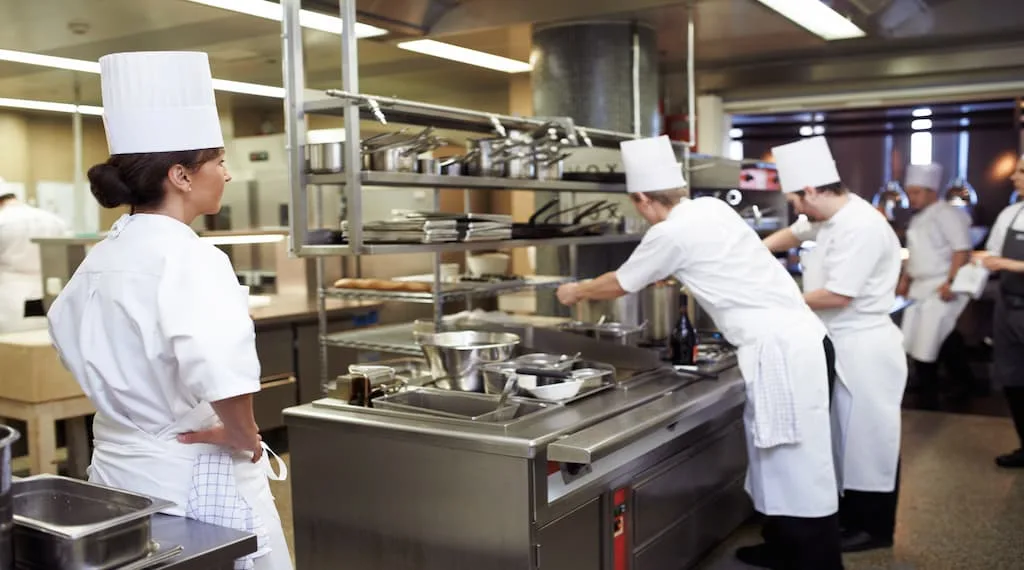
Shelving as a Branding Tool
Using commercial kitchen shelving as a branding technique is both creative and practical. It enhances the beauty of your kitchen while reinforcing your brand identity. Display your branded items as a free advertisement for your company and use them as a focal point to highlight anything you want to draw customers’ attention to.
Painting shelving units in a way that complements your brand’s color strategy results in a coherent appearance and enhances brand recognition.
Using theme décor pieces represents your brand’s personality and highlights the cuisine you serve while integrating the environment with your restaurant’s theme. For instance, if you serve Italian cuisine, use related accessories and create a relevant ambiance using shelving with different materials and shapes.
Change the display on your shelves periodically to reflect seasonal promotions, holidays, or special events. This keeps the kitchen environment dynamic and encourages repeat visits.
Selecting the Right Shelving Style
The right kitchen shelving style meets all the storage requirements, creates a coherent environment that integrates with the kitchen’s design and enables a smooth workflow. Combining different types of shelving can accommodate every storage need and specialize your kitchen space according to your unique taste. The shape and size of the kitchen shelving, along with the material, determine the kitchen layout and design theme.
Solid kitchen shelving features flat, solid shelves with no holes. It is mostly made of stainless steel or plastic. Solid shelves are sturdy and can hold heavy items and equipment. Unlike wire shelving, the flat surface is suitable for storing small items without falling through. Their flat surface is easy to clean, and some types have raised edges to prevent items from falling off. However, they are not effective for storing dry goods since they don’t have air circulation like wire shelving. Solid kitchen shelving gives the kitchen a more industrial look.
Wire and vented kitchen shelving is a versatile and durable shelving style. It is made of wire grids supported by metal poles, allowing great air ventilation and visibility. The open design accumulates less dust and dirt, yet the wires are not as easy to clean as solid shelves. With air circulation, they extend product life and avoid mold growth while providing easy visibility and access to the items. They are versatile and mostly used in pantries for storing dry goods or tools.
Open shelving keeps items visible and easily accessible while giving the kitchen a modern and neat look. Open kitchen shelving reduces time spent searching for items and takes up less wall space. It can make the kitchen look bigger and more airy, especially in small kitchens. They can also be mounted in every corner and unused space, maximizing storage. Yet, the one biggest drawback of the open shelves is they accumulate dust and debris more than closed cabinets, which can be more laborious to clean. They need to be organized every time to eliminate a cluttered look in the kitchen.
Specialty kitchen shelving types are designed to meet specific storage requirements for specific equipment or purposes. Dunnage racks are specialty kitchen racks designed to hold huge and bulky items off the floor that can not be stored on standard shelves, such as huge items or heavy containers and bags of goods. They ensure food safety and cleanliness, meet health standards, and prevent the goods and items from debris and moisture on the floors. The raised design from the floor makes the cleaning process easier and also enhances air ventilation for dry goods. They are made of durable materials with high load capacities, such as steel, aluminum, or polymer.
Pot and pan racks are designed to hold pots, pans, and cooking tools organized. They are mostly installed on walls or ceilings near cooking stations, providing easy access to the cooking tools. They are designed to save cabinet and shelf space while also facilitating the process with easy reach and giving the kitchen design a beautiful touch. They come in various shapes, such as grid style or shelf style, and can be made of wood, iron, and steel to suit any kitchen design.
Cantilever shelves are another specialty kitchen shelving designed to keep huge and awkward-shaped tools and equipment and feature no front posts. Its design allows for easier access, provides more storage space, and saves kitchen space by using overhead space.
Selecting the Right Shelving Material
The kitchen shelving material, whether steel, wood, polymer, or glass, has a huge impact on the theme of the kitchen. Shelving material constitutes one of the biggest parts of kitchen design and environment.
Stainless steel is a durable, heavy-duty shelving material that gives kitchens an industrial, modern look. It is popular due to its durability, resistance to corrosion, high loading capacity, and ease of cleaning. The sleek design of stainless steel shelving can complement many different kitchen designs.
MDF is made of numerous wood fibres binded together to form a board. It is durable and easy to clean with finishes such as laminate.
Plywood is a durable type of manufactured wood used in kitchen shelving.
HDMR, high moisture-resistant shelving board, is a mixture of fiber chips and forest wood waste, which is also highly durable and resistant to moisture. These wood shelving boards are made of recycled materials, making them an eco-friendly option.
Polymer or polypropylene shelving is a kitchen shelving material with a high corrosion resistance. They mostly feature metal inside, coated with some kind of plastic, providing more shelf strength.
Customization Option
Custom shelving solutions meet the specific aesthetic and functional needs of a kitchen. Customization allows for choosing the best options to be tailored to each kitchen’s specific storage requirements, design themes, and functional needs. Customization options for commercial kitchen shelving include shelf size and configurations, interior compartments and additions, specialized shelves, and various finishes.
Custom shelving configured to the required size and shape completes your kitchen layout flawlessly and maximizes storage by using available space efficiently without sacrificing wall and floor space. Choose the size of the shelves based on your layout and the size of the items that will be stored.
Customization offers designing kitchen shelving with movable shelves and drawers. This adjustability enables placing different-sized items and changing the heights of shelving according to changing storage needs.
Commercial kitchen shelving can be customized with special compartments for certain equipment or tools. Compartments can be designed to hold cutting boards, knives, jars, or small items to provide easy access and reduce clutter inside the shelving and on the counter.
Customization covers the finishes and coatings of the shelves. Choose from a variety of materials, finishes, and colors to complement your kitchen’s style and design theme. Whether you want to give your kitchen a sleek, modern, or conventional and cozy look, customization enables you to achieve the required theme while also creating a unique space.
Future Trends in Commercial Kitchen Shelving
In forthcoming commercial kitchen shelving design and material trends, there is a noticeable change toward a combination of practicality, aesthetics, sustainability, and innovation. Open shelving remains popular, and it is increasingly being used with integrated lighting solutions to highlight exhibited products.
Combining elements such as wood, metal, glass, and stone creates visual interest and enables customization to fit a variety of kitchen designs. Sustainability is another trend becoming increasingly important, with eco-friendly materials like reclaimed wood and recycled metal gaining popularity.
Floating shelves provide a clean, minimalist appearance while optimizing space, while modular shelf solutions are flexible and adaptable. Innovations such as pull-out drawers, adjustable dividers, and matte finishes help to provide efficient storage while maintaining a modern aesthetic.
It’s crucial to prioritize flexibility, timeless aesthetics, high-quality materials, technological integration of advanced kitchen shelving, and cooperation with design specialists to integrate these shelving trends into existing kitchen designs for future-proofing. By carefully combining these features, companies can design not only elegant and practical kitchens but also kitchens that are flexible to changing requirements and trends throughout time.
Conclusion
In conclusion, integrating commercial shelving with kitchen design themes greatly helps create functional, aesthetically beautiful, and operationally sound commercial kitchens. Businesses can improve the whole atmosphere of their kitchens by carefully selecting the correct shelving materials, designs, and customization options, in addition to optimizing storage capacity and workflow efficiency.
Every decision, from matching shelf options to common layout ideas to harnessing customization for personalized solutions, helps create a unified and effective atmosphere. Kitchen shelving’s use as a branding tool demonstrates its adaptability. It has the potential to strengthen brand identification and engage customers through smart display options.
As future trends emphasize practicality, sustainability, and innovation, the need to select adaptable, high-quality shelf solutions becomes clearer. In essence, commercial shelving is a cornerstone of kitchen design, acting not only as a functional need but also as an important component in establishing the visual story and operational effectiveness of commercial kitchens.

